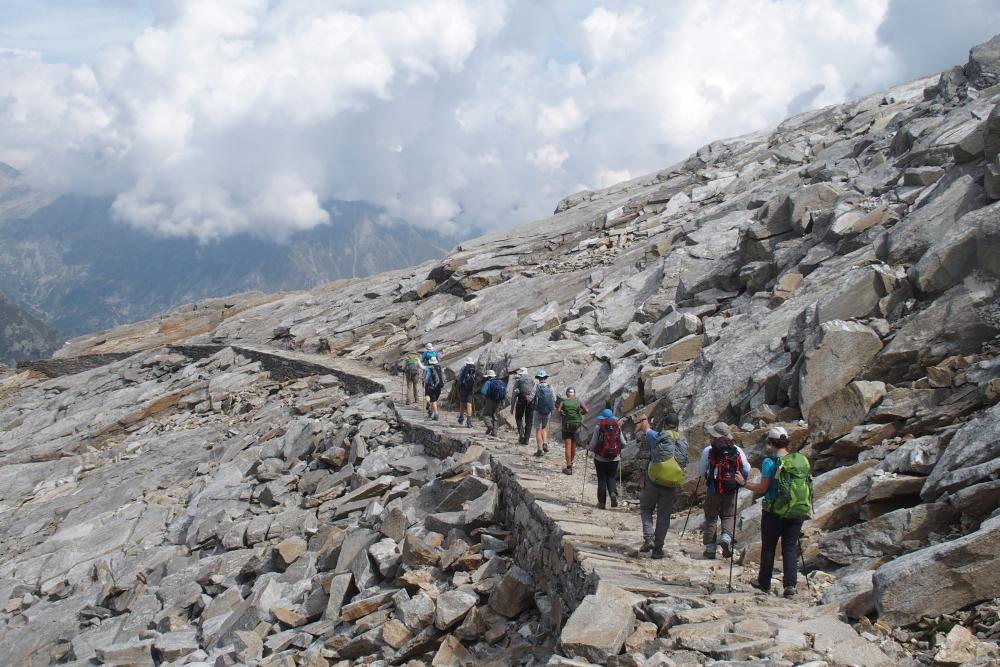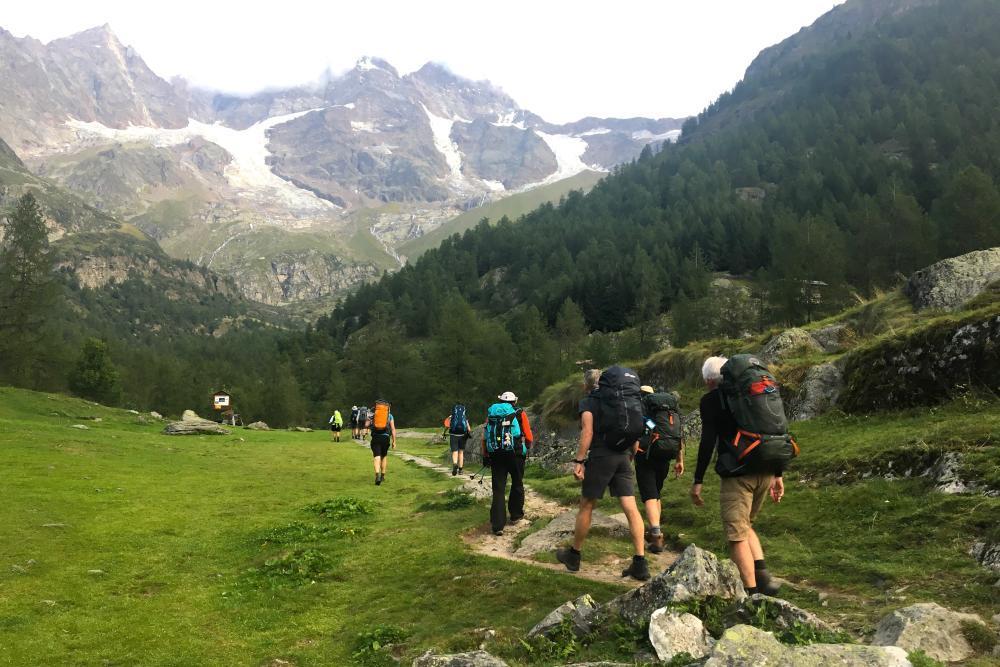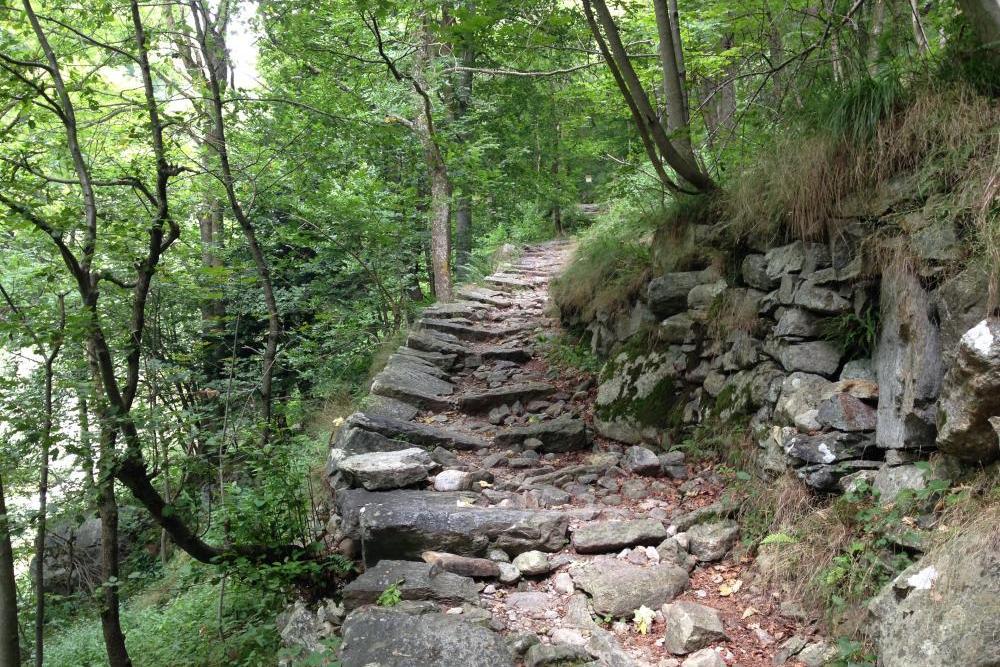Keeping the memory of the trails to freedom alive
Trails to Freedom is the story of a solo hike across the Alps that brings to life the history of the Anzac POWs who escaped Fascist Italy to find safety in neutral Switzerland during WWII. In October 1943, four Australian soldiers left Biella in the foothills of the Alps in northern Turin, fleeing Italy's Nazi-Fascist regime. With the help of local partisans the soldiers crossed into neutral Switzerland. They were four of more than 500 Anzac POWs who followed the sentieri della libertá, the trails to freedom. Decades later, author Simon Tancred embarks on a modern-day pilgrimage along the same route. We’ve asked him some questions about his book.
 Leaving Passo del Turlo. Photo: Simon Tancred
Leaving Passo del Turlo. Photo: Simon TancredWhen and how did you first encounter the history of the flight path along the Italian Alps?
One of the soldier’s (Carl Carrigan) daughters was a friend of my wife. She approached me to help her organise a family ‘pilgrimage’ to Italy to follow in her late father’s footsteps as a POW in Italy, which I did, but it was the escape and the route they took in September 1943 that really fascinated me.
Who were the four Australian soldiers that you mention in your book, who crossed the trail in October 1943?
Carl Carrigan, Paul Carrigan (brothers), Ron Fitzgerald and Lloyd Ledingham. A remarkable thing is that these four men were friends in Moree (a small town in outback New South Wales), they signed up together in 1940, trained together, were shipped to Palestine together in 1941, were taken prisoner together, were in prison in Italy for 2.5 year together, and then escaped to freedom in Switzerland together and, finally, were repatriated and arrived home in Moree in the end of 1945, always together!
What sources did you use to describe the fates and experiences of the Anzac soldiers who walked the trail?
Cate had put together a type of memoir (20 pages or so) based on the stories her father told her (not many!) and the memoirs of some of the other men. I also referred to a book by Katrina Kittel (Shooting Through) that is a history of this period. I received a lot of information from Dr Enrico Pagani, the director of the Istituto della Resistenza in Varallo in Piedmont, as well as sourcing a lot of information from locally published books and websites around Biella, the Valle Cervo, Alagna, Macugnaga and Valle Ossola.
 Setting out Monte Rosa. Photo: Simon Tancred
Setting out Monte Rosa. Photo: Simon TancredYou've walked the same route. Could you describe the landscape and your experiences?
It is very rugged Alpine terrain created by earthquakes and carved by glaciers. Much of the walk is above the treeline so it is bare, exposed rocky country, without human presence for a couple of days. It is 100 kms long, crosses 5 passes (several over 2500 mts) and walks through four different valleys.
What dangers did the soldiers encounter at the trail and what was the role of the partisans who helped them?
The soldiers had inadequate clothing and footwear (just street clothes they were given in Biella), they didn’t speak the language, they had no food, they had no maps or directions, and they were passing through enemy-held country. Italy switched sides on 8 September 1943 when the prisoners were released, there was something of a short hiatus as the Nazis re-established their control of the area, which allowed the POWs to move carefully.
Fortunately, this area had not fully embraced Fascism, even from its early days. There were a lot of communist-sympathetic, unionised factories in the valleys and the mountain folk often resented the Fascist bullies, so there was a lot of sympathy for the POWs. The POWs could not have made it at all without the support particularly of ordinary, local people, who provided directions, shelter, food etc, of course at enormous risk to themselves and their families, but also, to a lesser degree, of the partisans, who were only really in the early stages of forming at this point.
 Climbing to Rifugio Rivetti. Photo: Simon Tancred
Climbing to Rifugio Rivetti. Photo: Simon TancredWas this route also used by others, like soldiers from other countries or Jewish refugees?
Yes. Slightly less than five hundred ANZAC (Australian and New Zealand) POWs made it over the Monte Moro and neighbouring Monte Modelli Pass before the winter of 1943/1944 and the Nazis locking it down in March 1944. There were several different routes to actually get to the Monte Moro and Mondelli passes.
There were also some Jewish refugees (I believe many from Turin) but I’m not sure of the numbers, but not so many. There were a few British POWs but again not so many.
By the way, the reason for the high presence of ANZAC POWs in this area was that five hundred of them had been sent from a larger camp near Udine in the north-east of Italy to work in the rice fields around Vercelli in April 1943. The larger camp near Udine (Campo 57 at Grupignano, to be precise) held five thousand ANZAC POWs who had all been taken prisoner fighting with British forces against the Italian/German forces around Tobruk and El Alamein in early 1941.
Your book is also a remembrance to your uncle John. Who was he and what happened to him during WWII?
John Fairfax Tancred was born in 1912. He was seven years older than my father. They were raised on a cattle property (ranch) in south-west Queensland. John’s military experience followed those of Carl Carrigan and his friends, to a point. Like them, John signed up as a regular soldier in 1940, went to Palestine for training, got shipped to North Africa in early 1941 and was taken prisoner (a month or two later than Carl). John was put into a prison ship bound for Italy but, unfortunately, the unmarked ship was torpedoed by a British submarine. The ship survived but John was in the section that was hit by the torpedo and was killed by the explosion. My father, who also served in the Second World War (but in New Guinea against the Japanese) adored his older brother so the memory of John had a presence in our home.
Besides this book, how do you keep the memory of the trails to freedom alive?
The main way that I have kept this story alive is via the annual ‘Trails to Freedom’ hike, which is a 10-day hike following the POWs’ escape route, which we do in late-August. We have run this hike (maximum twelve people) every year since 2015 (except, of course, two years over Covid). It has proved very popular: it is booked out for 2025 and 2026, and we now have a waitlist for 2027!
The really satisfying thing is that this regular presence of a group of Australian hikers arriving every year has stimulated interest in the locals’ own often long forgotten history, particularly in Macugnaga, the last town before the Monte Moro Pass. There are always articles about the group in the local newspaper (Il Rosa) and they now include a section in the Macugnaga museum about these events. Last year there was a plaque placed at Monte Moro Pass to commemorate the events (with local dignitaries) and this year they have a small celebration organised for the 10th anniversary of the hike.
Simon Tancred had an hour long interview on the ABC about the book and the story. You can listen to it here.
Used source(s)
- Source: Simon Tancred / TracesOfWar
- Published on: 23-06-2025 08:50:27
Related news
- 12-04: Understanding the German side of the fighting in Normandy
- 11-'24: Postal artifacts provide a vibrant testament to the experiences of the Dutch people during WWII
- 10-'24: DigitalBattlefieldTours unlocks military tactics to a wide audience
- 08-'24: Researching his father’s WWII history became a passion for Steve Snyder
- 08-'24: Who was the owner of the photo album from Dachau?
Latest news
- 11-11: Are Black soldiers being erased from history once again?
- 10-11: Limburg demands answers over U.S. whitewashing of Black history at WWII cemetery
- 03-10: Photo report other Airborne commemorations and events 2025
- 01-10: Photo report commemoration Wiltshire memorial
- 30-09: Photo report other Airborne commemorations and events 2025
- 26-09: Photo report Ounveiling Plaque 'Gunners within 1st Airborne Division'
- 25-09: Photo report unveiling Plaque 'Gunners within 1st Airborne Division'
- 24-09: Photo report Airborne commemoration Driel
- 23-09: Photo report Airborne Landing and Commemoration
- 22-09: Photo report Airborne Memorial Service Oosterbeek


